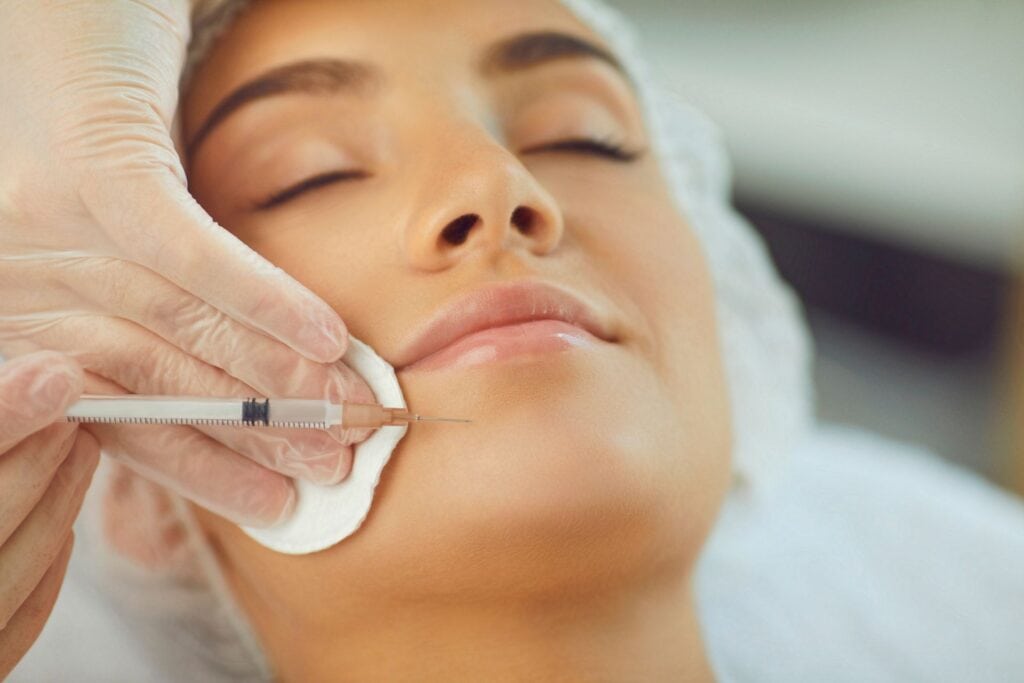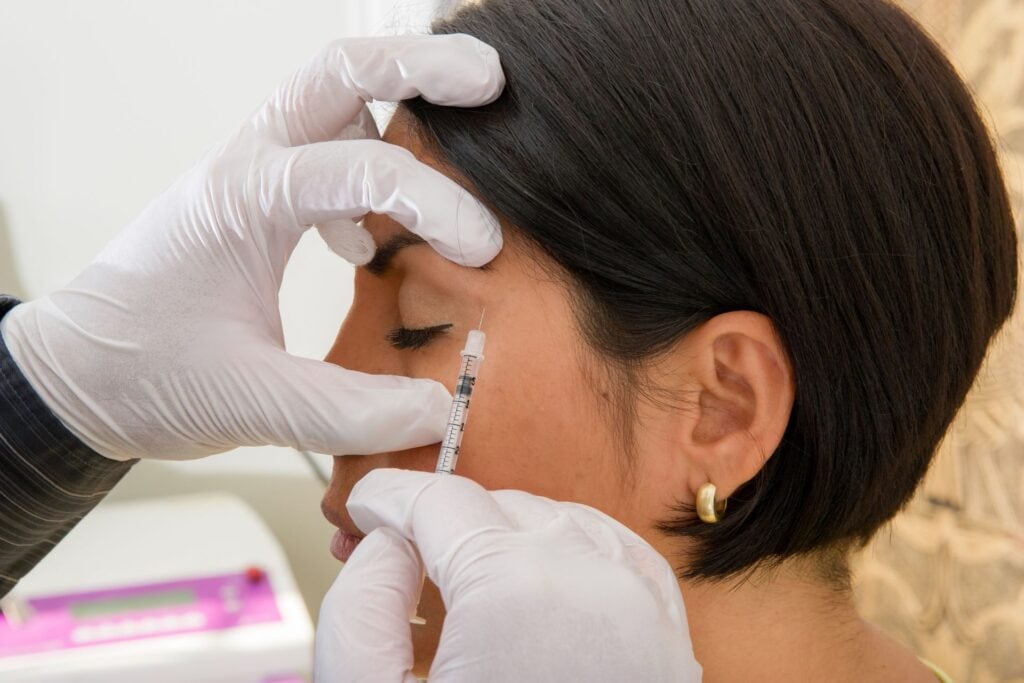Botox has become a popular aesthetic treatment for many individuals seeking to reduce signs of aging. Botox is an injectable neuromodulator, which acts on the facial nerves and muscles to decrease wrinkles in the skin that are caused by repetitive expressions such as frowning or squinting. This article will discuss the benefits of this treatment and provide an overview of its medical use.
Dermatologists have long been aware of the potential anti-aging effects of Botox injections. In recent years, these treatments have grown significantly in popularity due to their ability to enhance facial features while providing minimal risk with excellent results. A common misconception about this procedure is that it only works on reducing wrinkles; however, there are several other uses associated with Botox injection therapy.
In addition to addressing cosmetic concerns like fine lines and creases, Botox can also be used therapeutically to help address various conditions such as excessive sweating, migraines, muscle spasms, neck pain, and even bladder issues. As one considers all the possible applications for this powerful neurotoxin, knowledge about its safety profile becomes increasingly important when considering whether or not it is right for them.
Body Parts For Botox Benefits
- Forehead
- Eyes (Crow’s feet)
- Neck
- Chin
- Jawline
- Nose
- Lips
- Cheeks
- Around the mouth
- Frown lines
- Brow lift
- Hyperhidrosis (excessive sweating)

Uses And Applications
Botox is a form of botulinum toxin, which has been used for decades in the medical field to treat a variety of conditions. It acts as an effective and safe muscle relaxant that can be injected directly into certain areas of the body. Botox injections are most commonly used by dermatologists to reduce wrinkles or improve facial contours.
Uses
- Reduce wrinkles
- Improve facial contours
- Treat overactive muscles from chronic migraines
In addition to reducing wrinkles and improving facial contours, Botox can also help with other medical issues, such as treating chronic migraine headaches and excessive sweating, known as hyperhidrosis. This treatment works by blocking signals sent from nerves to the injected area’s sweat glands, preventing them from producing more sweat than normal. The effects usually last between six months and one year, depending on how much was administered and where it was placed on the body.
Botox injections have become increasingly popular due to their ability to provide quick results without requiring any surgery or downtime after treatment. With regular use, patients can expect noticeable changes in their appearance while having minimal risk of side effects when treated properly under qualified supervision. As such, it is important for those considering this type of treatment to consult with a trusted physician who understands all potential risks before proceeding with injections.
The ease of use and effectiveness offered by Botox makes it an attractive option for many people looking to improve their appearance; however, they should always seek professional guidance before undergoing any treatments involving injectables like Botox or dermal fillers in order to ensure safety considerations are met.
Make sure you don’t miss what you need to know about Botox.
Benefits for Face
Botox is a popular and effective treatment for wrinkles and facial lines due to its ability to temporarily reduce muscle activity. The injection works by blocking nerve signals to the muscles, relaxing them and allowing the skin to appear smoother and more youthful. Botox is most commonly used to reduce wrinkles on the forehead, between the eyebrows, and around the eyes. It can also be used to reduce wrinkles on the neck, jawline, and chin. Additionally, Botox can be used to lift and shape the eyebrows, soften the appearance of a square jawline, and correct a gummy smile.
Benefits For Skin
Botox is a popular cosmetic treatment used to reduce the appearance of wrinkles on the face. It works by temporarily paralyzing the muscles responsible for causing wrinkles, allowing the skin to appear smoother and more youthful. The benefits of Botox for skin include reducing the appearance of wrinkles, improving skin elasticity, preventing new wrinkles from forming, and improving facial symmetry. Botox also provides a temporary solution to aging skin, allowing users to maintain a youthful appearance without a long-term commitment.

Benefits of Masseter Botox
Masseter Botox is a popular cosmetic procedure that can help to reduce the appearance of a square jawline and create a more oval, feminine facial shape. This procedure can help to reduce the size of the masseter muscle as well as tighten and define the cheekbones. Benefits of masseter Botox include a more balanced facial shape, smoother skin, and an improved overall appearance. Additionally, this procedure can help to reduce grinding and clenching of the teeth and can be an effective solution for those suffering from TMJ.
Check out our Botox service page to know more about how RFSA Dermatology injects this treatment.
Safety Considerations
The safety of Botox depends on its proper administration. When administered by a qualified and experienced dermatologist, it has been proven to be safe and effective in reducing the appearance of wrinkles. In order to ensure patient safety, it is important that the dosage is monitored carefully. Additionally, administering too much can cause side effects such as droopy eyelids or heavy brows, so practitioners should take care not to exceed recommended dosages.
It is also important for patients to disclose any health issues they may have prior to their treatment session. This includes conditions like allergies, neurological disorders and muscular diseases which could influence how safely Botox is administered. Furthermore, pregnant women are advised not to receive injections due to potential risks associated with fetal development.
By considering these safety factors when receiving Botox treatments, individuals can enjoy the benefits of reduced wrinkles without compromising their overall wellbeing. The next step is understanding the potential side effects associated with this cosmetic procedure.
Potential Side Effects
Now that the safety considerations for Botox have been explored, this section will delve into potential side effects of its use. In some cases, these risks can be minimized or avoided altogether through appropriate administration and patient education.
| Potential Side Effects | Ways to Minimize |
|---|---|
| Pain during injection | Administer numbing cream prior to injections |
| Drooping eyelids/brow (ptosis) | Begin with a lower dose and increase gradually based on desired results |
| Swelling at the site of injection | Apply cold compress after injection and limit activity in treated area for 24 hours post treatment |
| Headache or flu like symptoms | Drink lots of water before and after treatment to help flush out toxins from body faster |
| Nausea / vomiting/dizziness | Follow instructions provided by doctor regarding when to take medications before/after procedure such as ibuprofen or acetaminophen if prescribed |
It is important to note that while rare, there are more serious side effects associated with Botox which should not be overlooked. These include breathing difficulties, blurred vision, muscle weakness, difficulty swallowing, rash or hives, itching or tingling sensation near the injection sites. If any of these occur it is imperative to seek medical attention immediately.
In light of all possible side effects associated with Botox it is essential for patients to fully understand their individual risk level prior to committing to treatment. Patient education can play an integral role in minimizing potential risks stemming from Botox use and should always be taken into consideration when considering alternatives.
Alternatives
The options available to individuals seeking a similar effect as Botox are abundant and varied. One can scarcely keep track of all the choices; so vast is the selection! To help narrow down these alternatives, here is an exhaustive list:
Surgical interventions
- Facelift
- Lip lift
- Brow lift
Non-surgical treatments
- Fillers such as hyaluronic acid to plump up wrinkles or folds.
- Carbon dioxide (CO2) laser resurfacing which uses computer technology to precisely target problem areas while leaving healthy tissue untouched.
- Chemical peels that use a variety of acids to remove layers of dead skin cells, revealing smoother and softer skin underneath.
- Topical treatments
- Retinol creams to reduce fine lines and sun damage.
- Peptide serums containing collagen boosters and antioxidants to protect against environmental pollutants.
- Sunscreen with SPF 30 or higher for daily protection from UV rays.
All in all, there are a multitude of methods one can employ when attempting to achieve the same result as Botox without having to resort to injections. For those who prefer not taking any drastic measures, topical treatments offer safe yet effective solutions that do not require surgery or downtime afterwards. With careful consideration, it is possible for anyone interested in achieving younger looking skin without needles find an appropriate solution tailored specifically for their individual needs.
Frequently Asked Questions
What Is The Average Cost Of A Botox Treatment?
Botox is a popular cosmetic treatment for people seeking to reduce wrinkles and fine lines on the face. It typically requires multiple injections of the botulinum toxin, which results in muscle relaxation, improving skin’s appearance. The cost of this procedure can vary significantly depending upon several factors, including the number of treatments needed and geographical location.
The average cost of a single Botox session may range from $150 to $400 per area treated. For example, if someone wanted to treat both frown lines (the 11s) as well as crow’s feet around their eyes, they would need two separate sessions at different costs. A lot depends on where one lives; many doctors charge more in major cities due to higher overhead expenses such as rent. Additionally, it is important to keep in mind that the price may differ between physicians based on their training level and experience with administering injectables.
How Long Do The Results Of Botox Last?
Botox is a popular non-surgical procedure for cosmetic improvements to the face and neck. It has been used since 2002, when it was approved by the Food and Drug Administration (FDA). Many people are interested in learning more about its effects and how long they last. This article will discuss how long results of Botox typically last.
The duration of the results of Botox depend on several factors including lifestyle choices, age, muscle structure, technique used during injection, and amount injected. Typically, if injections are done correctly and proper aftercare procedures followed, results can last up to 4 months or longer with some patients having their effects linger even beyond that time frame. Generally speaking though, most individuals find that touch ups become necessary around 3-4 months post treatment.
Individuals who exercise regularly seem to experience shorter lasting results due to increased muscular activity which breaks down the product faster than usual. Similarly those who take part in activities like yoga or Pilates may also find themselves needing more frequent re-treatments as these increase facial muscles’ mobility causing them to weaken over time thus shortening the efficacy period of Botox treatments. Age also plays an important role in determining longevity of botulinum toxin; younger patients tend to have longer effect durations compared to older ones because skin elasticity naturally decreases with age impacting effectiveness of treatments overall.
Are Botox Treatments Painful?
Botox treatments are a popular cosmetic procedure for reducing facial wrinkles, though some may worry about the potential pain associated with receiving such injections. To determine whether botox is painful and to what extent, one must first understand how it works.
Take the case of Mary, a 50-year-old woman who decided to have Botox injections in order to reduce her forehead wrinkles and crow’s feet around her eyes. As a dermatologist, I explained that Botox works by blocking nerve signals from muscles in the face so they can no longer contract or move. This helps relax the underlying muscle groups responsible for causing wrinkles on the surface of the skin. After discussing this process with Mary she was able to better understand why there might be discomfort during treatment.
In general, most patients experience mild discomfort when undergoing Botox injections as it is administered using very small needles directly into targeted areas of contracted muscles in the face. The sensation has been described as similar to an ant bite which typically resolves quickly. Additionally, topical numbing cream can also be applied before injection if desired; however this will lengthen treatment time slightly and does not significantly decrease any pain felt from needle insertion.
How Often Should Botox Treatments Be Repeated?
Botox treatments are an effective way to reduce wrinkles and fine lines caused by aging, sun damage, and other factors. However, for optimal results, it is important to consider how often these treatments should be repeated. Dermatologists recommend that Botox injections be done every three to four months in order to maintain the desired effects of reducing wrinkles and lines.
In general, people who have had previous Botox injections will need less frequent treatment sessions as time goes on due to a gradual weakening of muscle movement in the areas injected with Botox. This means that fewer units may be used at each session over time. It’s also possible for some patients with dynamic wrinkles or deep-set expression lines to need more frequent maintenance injections for best results.
The frequency of your Botox treatments can vary depending upon individual needs and preferences; however consulting a dermatologist beforehand can help ensure you get optimal outcomes from your procedure. Our team has experience helping individuals find a customized plan tailored specifically towards their goals and aesthetic desires. If you’re considering getting injectables such as Botox, we’d love to discuss what options would work best for you!
Are There Any Age Restrictions For Botox Treatments?
Botox treatments are becoming increasingly popular for their potential to reduce the appearance of wrinkles and give skin a more youthful look. However, there remain certain restrictions on who can receive these treatments, including age restrictions. This article will explore what those limits are so that individuals considering Botox can be informed about which treatment options may be available to them:
- Age requirements
- Risks associated with age
- Alternatives to Botox
As an experienced dermatologist, it is important to consider the implications of undergoing any cosmetic procedure like Botox – particularly when it comes to age restrictions. While younger people may still enjoy the benefits of this type of wrinkle-reducing therapy, they must also understand its risks as well as other alternatives that exist in order to make a fully informed decision.
In terms of age restrictions, most practitioners recommend waiting until one’s mid-to-late twenties before pursuing Botox injections or other similar aesthetic procedures. The reason behind this recommendation is largely due to two factors: firstly, individuals under the age of twenty-five have not yet developed significant signs of aging; secondly, those same individuals could potentially experience unexpected side effects from such treatments if their bodies haven’t had time to mature completely. That said, exceptions can sometimes be made depending on a person’s individual situation and needs.
The possible risks associated with receiving botulinum toxin (the active ingredient in most forms of Botox) at a young age should also be taken into consideration prior to making any decisions regarding treatment. These include temporary muscle weakness and paralysis, headaches, facial drooping, vision problems and even permanent nerve damage in extreme cases – all of which highlight why an individual’s safety should always come first when considering any course of action related to beauty enhancement procedures.
Furthermore, there are several alternative ways for addressing wrinkles without necessarily having to resort to injectables like Botox or dermal fillers. Options such as skincare regimens tailored specifically towards improving skin elasticity and reducing fine lines; lifestyle modifications aimed at tackling stress levels; and laser resurfacing techniques designed for collagen stimulation are just some examples worth exploring further before committing to any particular solution.
To sum up, while there are various reasons why someone might opt for Botox treatments – ranging from vanity concerns through medical necessity – understanding the limitations imposed by age is essential for anyone interested in taking advantage of its potential anti-aging properties safely and responsibly. A comprehensive evaluation from a qualified practitioner coupled with knowledge gained from research conducted independently can help ensure that whatever choice is ultimately made turns out to be both beneficial and rewarding long term.
Conclusion
Botox, a widely used treatment for wrinkles and fine lines, has attracted the attention of many people seeking to improve their skin’s appearance. It is essential to be familiar with the facts regarding Botox treatments in order to make an informed decision about it. The cost of Botox varies depending on the area being treated, but can range from $200-400 per session. Depending on individual factors such as age and lifestyle, results may last up to four months or longer. Though there are some sensations associated with injection, most patients find them tolerable. Typically, repetition of treatment every three to six months yields best results. Generally speaking, anyone over 18 years old can receive this type of treatment; however, it is important that individuals consult with a dermatologist prior to any procedure.
In conclusion, understanding the facts related to Botox helps potential users assess if they would benefit from its use. Taking into account both costs and frequency of visits will aid in making an educated decision concerning this form of cosmetic enhancement. Furthermore, those considering receiving botulinum toxin injections should only do so under the supervision of a licensed professional who understands facial anatomy and medical history thoroughly before performing any procedures.



